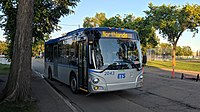NABI Bus, LLC (NABI) is a manufacturer of heavy-duty transit buses with its headquarters, bus manufacturing and assembly operations, located in Anniston, Alabama. Its products ranged from 31-feet to 60-feet in length, and were sold to operators throughout the United States and Puerto Rico. NABI's U.S. operations also include an aftermarket parts division in Delaware, Ohio, and an after-sales service center at Mira Loma, California.

Nova Bus Inc. is a Canadian bus manufacturer headquartered in Saint-Eustache, Quebec, Canada. Nova is owned by Volvo Buses, a division of the trucks, buses and construction equipment group Volvo.
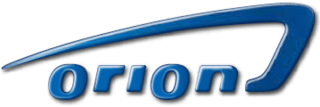
Orion Bus Industries, formerly Ontario Bus Industries in Canada and Bus Industries of America in the United States, was a privately owned bus manufacturer based in Mississauga, Ontario, Canada. Until 1995, the word Orion was only a model or brand name, not part of the company's name. It was renamed DaimlerChrysler Commercial Buses North America in 2006, but continued to market its products under the Orion name.
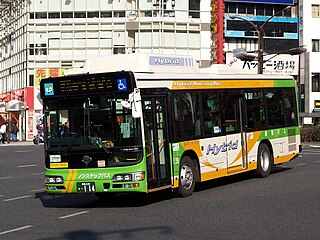
A hybrid electric bus is a bus that combines a conventional internal combustion engine propulsion system with an electric propulsion system. These type of buses normally use a Diesel-electric powertrain and are also known as hybrid Diesel-electric buses.
Neoplan USA was a major transit bus manufacturing company based in Denver, Colorado. It started as a subsidiary of the German corporation Neoplan in 1981 with its main factory and headquarters in Lamar, Colorado. In 1998, Neoplan USA was acquired by Willis Stein & Partners and became an independent licensee of designs from the German company Neoplan. The company declared bankruptcy in 2006.
Metrobus is a public transport system owned by the City of St. John's, Newfoundland and Labrador, Canada. It operates a fleet of diesel buses. A total of 25 bus routes serve St. John's and its western suburbs of Mount Pearl and Paradise, carrying 2.9m passengers in 2016.

Victoria Regional Transit System provides public transportation in the Greater Victoria region of British Columbia, Canada. Its operations are governed by the Victoria Regional Transit Commission in association with BC Transit. There were more than 25 million riders in 2010.

The Altoona Transportation Center is an intermodal passenger facility built in 1986 providing local bus, intercity bus, and rail services. It is located at 1231 11th Avenue in downtown Altoona, Pennsylvania. It replaced the original PRR Altoona station built in the 1880s. The Transportation Center's modernist-influenced main building is built into the lower levels of a parking garage and connects to a network of pedestrian bridges which criss-cross the busy roads and tracks surrounding the facility. The Center also features a 300-foot-long bus platform capable of serving up to 9 buses at once. The interior of the Center has space for businesses previously home to offices and a cafe, which now sit vacant, leaving the Center's only two tenants as Amtrak and Greyhound.

The Orion I was a line of rigid high-floor transit buses available in 30', 35', and 40' lengths manufactured by Ontario Bus & Truck between 1976 and 1993 for the Canadian and United States mass transportation markets. The Orion I was the first bus offered by OBI and was available in transit (2-door) and coach/suburban (1-door) models. It was replaced by the rigid Orion V and low-floor Orion VI.
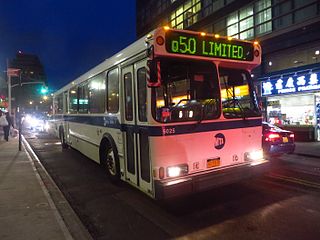
The Orion V was a line of rigid high-floor transit buses available in 32', 35', and 40' lengths manufactured by Ontario Bus Industries between 1989 and 2009. The conventionally powered buses, either with longitudinally mounted diesel or natural gas engines, used a T-drive transmission coupling. The Orion V replaced the rigid Orion I, and was in turn replaced by the rigid low-floor Orion VI and Orion VII.

The Orion VI was a low-floor transit bus available in 40' lengths manufactured by Ontario Bus Industries between 1995 and 2003. The Orion VI was intended to provide an alternative to the existing high-floor Orion V; both the V and VI were replaced by the partially low-floor Orion VII.

The Orion VII was a line of low-floor transit buses available in 30' rigid, 35' rigid, and 40' rigid lengths manufactured by Orion Bus Industries between 2001 and 2013 in three generations. The conventional powered buses, either with longitudinally-mounted diesel or natural gas engines, used a T-drive transmission coupling. A series hybrid variant powered by a diesel-driven generator was also available. The Orion VII replaced the fully low-floor Orion VI and high-floor Orion V buses, and was manufactured until its parent company DaimlerChrysler withdrew from the transit bus market in 2013.
Central Fraser Valley Transit System is a public transit system which provides bus services in the Central Fraser Valley area of British Columbia, Canada. Funding for the system is provided by the City of Abbotsford, the District of Mission, the University of the Fraser Valley and BC Transit, the agency responsible for planning and management of municipal transit systems throughout the province. Other than planning and managing bus routes, The Central Fraser Valley Transit System contracts out most of its bus services to FirstCanada ULC.
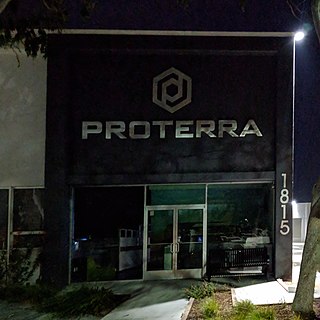
Proterra is an American automotive and energy storage company based in Burlingame, California. The company designs and manufactures electric transit buses and electric charging systems. Proterra's Catalyst series includes transit buses ranging from 35 feet (11 m) to 40 feet (12 m) in length and various battery configurations. Buses are charged through an overhead charging station that is placed at maintenance facilities as well as route terminals.

The New Flyer Xcelsior is a line of transit buses available in 35' rigid, 40' rigid, and 60' articulated lengths manufactured by New Flyer Industries since 2008. In addition to the different available lengths, the buses are sold with a variety of prime movers, ranging from conventional diesel and CNG combustion engines to diesel-electric hybrid, hydrogen fuel cell, and battery electric.

New Flyer Industries is a Canadian bus manufacturer owned by NFI Group. With various manufacturing facilities in Canada and the United States, the company produces the New Flyer Xcelsior family of buses.

The Flyer 700/800/900 series was a group of bus model series built by Western Flyer and its successors Flyer Industries and New Flyer, of Canada, between 1967 and 1987. They were three generations within a model grouping and, except for brief overlap during transition from one generation to the next, were not in production concurrently. All individual model designations included a prefix of either D, for diesel propulsion, or E, for electrically powered trolleybuses. The introductory model was the D700, originally released in 1967 for the Canadian transit market, and the last series group to be produced, D900, was discontinued in 1987. Flyer had become New Flyer only the year before, in 1986.

The NABI LFW was a line of low-floor transit buses available in 30' rigid, 35' rigid, 40' rigid, and 60' articulated lengths manufactured by North American Bus Industries (NABI) between 1997 and 2015. In addition to the different available lengths, the buses were sold with a variety of prime movers, ranging from conventional diesel and LNG/CNG combustion engines to diesel-electric hybrid.

The NABI SFW was a line of standard (high)-floor transit buses available in 40' rigid and 60' articulated nominal lengths, manufactured by the Ikarus USA joint venture, then by American Ikarus and North American Bus Industries (NABI) between 1989 and 2013. In addition to the different lengths, the buses were sold with a variety of prime movers, including conventional diesel and CNG combustion engines and hybrid diesel-electric power.

The NABI CompoBus was a line of low-floor composite-bodied transit buses available in 40' and 45' rigid lengths manufactured by North American Bus Industries (NABI) between 2002 and 2013. In addition to the different available lengths, the buses were sold with a variety of prime movers, ranging from conventional diesel and LNG/CNG combustion engines to diesel-electric hybrid.
